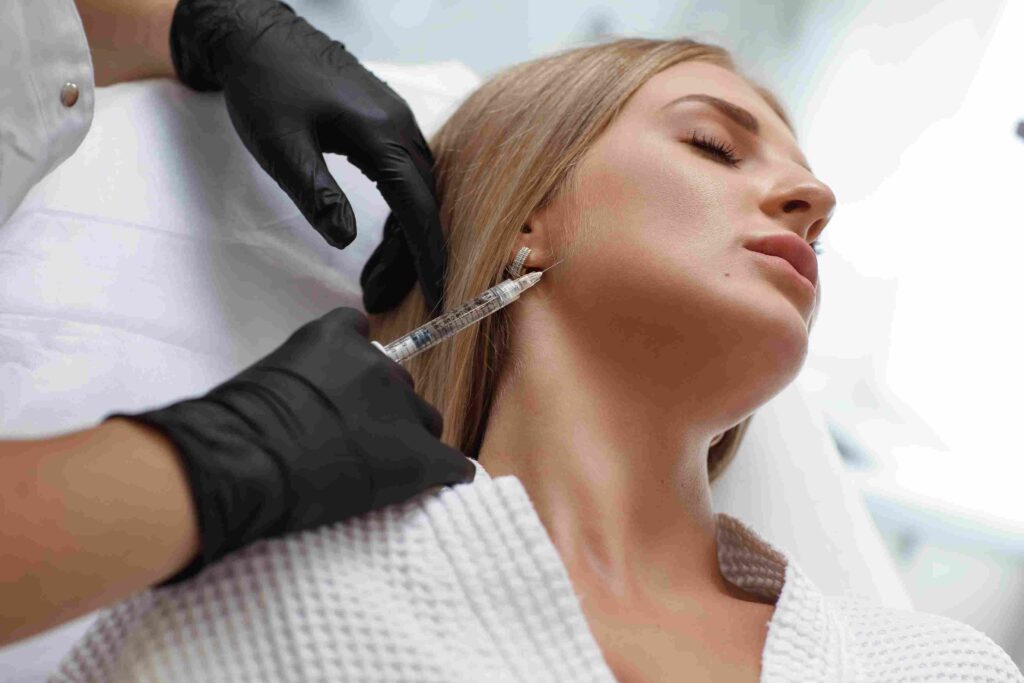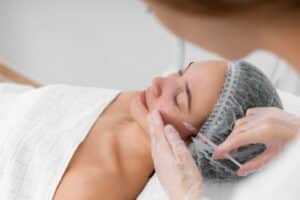Radiesse vs Sculptra: Which Filler Is Right for You?
Dermal fillers provide a permanent and flexible solution to the issue of how gradually decreasing volume changes the shape of the face. HS MedSpa offers a range of advanced injectable options through Dermal Fillers services, including Radiesse and Sculptra—two well-known choices that continue to generate patient questions.
Both are non-hyaluronic acid fillers that stimulate collagen, yet they behave quite differently both in the syringe and once placed beneath the skin. These differences affect everything from the comfort of the procedure to the quality and timing of the cosmetic results.
Learn more about how each one works, when it’s recommended, and how it can support your individual goals—so you can make the most informed decision.
What Is Radiesse? Composition, Mechanism, and Benefits
Radiesse is an injectable dermal filler comprised of a gel that contains smooth particles of calcium hydroxylapatite (CaHA). These particles are great for use in dental and skeletal restorations since they are very biocompatible. The gel adds volume and shape right away after injection, and the CaHA particles work underneath the skin’s surface to help the body make its own collagen.
Because it works in two ways, Radiesse treatment is great for patients who want both short-term and long-term outcomes. The firm lift helps the most with the jawline, cheekbones, and marionette lines. This filler is also FDA-approved for hand rejuvenation. It restores youthful fullness and makes tendons and veins seem less visible.
Many patients really like the “sculpted” appearance that Radiesse gives. Its thick consistency makes it perfect for structural work and contouring the face, especially when you want clear lines.
Is Radiesse better than Sculptra? If you want a quick and obvious difference, the answer is yes. But when looking at facial harmony across time, speed isn’t the only thing to consider.
What Is Sculptra? How It Works and Who It’s For
Sculptra functions differently. Rather than physically filling space with volume, it gradually encourages your skin to rebuild its own supportive matrix. The active ingredient—poly-L-lactic acid (PLLA)—is a synthetic compound safely used in medical applications for over 30 years, including dissolvable sutures.
Unlike Radiesse, Sculptra is injected deeper into the dermis, where it triggers fibroblasts to generate new collagen. This process takes several weeks and often requires a series of sessions to achieve optimal results. While it doesn’t provide the immediate lift that Radiesse does, the outcome is often praised for its soft, natural quality.
Patients who benefit most from Sculptra include:
- Adults with generalized facial volume loss
- People with thinner skin or a history of weight loss
- Individuals who prefer slow, subtle enhancement
- Patients aiming for long-term improvement with fewer touch-ups
Sculptra is particularly effective for treating large areas of facial hollowing—such as the temples, cheeks, and pre-jowl folds—without producing puffiness or overcorrection. For this reason, Radiesse vs Sculptra is not just a product comparison but a philosophical one: structure vs softness, immediate change vs gradual renewal.
Treatment Sessions and Timeline
One of the key differences between the two fillers is the treatment timeline. Radiesse is typically administered in a single session. Patients notice improvements immediately after injection, and the added benefit of collagen stimulation means results continue to improve over time. A follow-up visit might be scheduled after a year or more, depending on individual goals.
Sculptra, by contrast, is a staged treatment. Most patients require between 2 to 4 sessions, spaced 4 to 6 weeks apart. Each treatment lays the groundwork for gradual collagen synthesis. Visible results usually begin to emerge around 6–8 weeks after the first session, with full improvement appearing after a few months.
- Visible Results
- Radiesse: Immediate
- Sculptra: Gradual (6–12 weeks)
- Radiesse: Immediate
- Number of Sessions
- Radiesse: Usually 1
- Sculptra: 2–4
- Radiesse: Usually 1
- Best For
- Radiesse: Definition & lift
- Sculptra: Full-face soft volume
- Radiesse: Definition & lift
- Downtime
- Radiesse: Minimal
- Sculptra: Minimal
- Radiesse: Minimal
For patients trying to decide between Radiesse and Sculptra, the timeline is a major consideration. Radiesse offers a “quick win,” while Sculptra is an investment in time for a natural evolution.
Longevity and Maintenance
The duration of effects and the rate of aging are two further ways in which Radiesse and Sculptra vary.
Results with Radiesse usually show after 12 to 18 months. Natural collagen is left behind when the calcium microspheres gradually disintegrate, and this collagen might continue to work for months after the first lift fades. In most cases, maintenance is easy; patients only need to come back once a year to have touch-ups.
The duration of Sculptra, in contrast, maybe two years or more. The results age beautifully and simply need periodic reinforcing after the collagen has been restored. If you want results that last without having to make regular trips to the doctor, this is a good choice.
Both fillers do need care, but the amount and frequency of that upkeep will vary depending on the one you choose. If you’re looking for a low-frequency injectable option that yet looks natural, Sculptra might be a better fit. Radiesse provides the perfect combination of structure and support for those who prioritize instant gratification and clear lines.
Treatment Areas: Face, Jawline, Hands, and More
The versatility of both fillers makes them useful for a wide variety of treatment zones. Still, they excel in different contexts.
Radiesse treatment zones:
- Jawline and chin (for contouring)
- Cheeks (for midface lift)
- Nasolabial folds and marionette lines
- Back of the hands (FDA-approved)
Because of its density and firmness, Radiesse is excellent for reshaping and definition. It acts almost like an internal scaffolding system for the face—helping restore angularity or volume in areas where bone and fat have receded.
Sculptra treatment zones:
- Temples (for hollowing)
- Mid-cheeks (for subtle volume)
- Lower cheeks and jawline (for softening)
- Pre-jowl area
- Skin texture improvement (gradual thickening)
Sculptra is more suitable for full-face rejuvenation, especially in cases of diffuse volume loss. It helps reinforce the skin’s foundation rather than sharply changing its shape.
Can You Use Sculptra and Radiesse Together?
This is a question often asked during consultations: Can you use Sculptra and Radiesse together? The answer is yes—with the right technique and treatment plan.
In some cases, combining both fillers can achieve a balanced outcome:
- Radiesse may be used for defining the jawline and lifting the cheeks.
- Sculptra can address volume loss in temples and lower cheeks.
These products should not be injected in the same site or session unless planned carefully by an experienced injector. Their different mechanisms of action and physical properties require precision and understanding. When used wisely, they can complement each other beautifully—creating both immediate and sustained rejuvenation.
Risks, Side Effects, and Recovery
Like all injectable treatments, both fillers carry the risk of side effects—but they are generally low when performed by qualified professionals.
Radiesse risks:
- Temporary swelling, bruising, or tenderness
- Rare nodules, if injected too superficially
- Not reversible, unlike HA-based fillers
Sculptra risks:
- Temporary redness and swelling
- Risk of nodules or bumps if massage is skipped
- Gradual onset may delay the detection of asymmetries
Post-treatment massage is critical with Sculptra. Patients are advised to follow the 5-5-5 rule: massage the treated areas for 5 minutes, 5 times a day, for 5 days. This helps distribute the product evenly and prevents the formation of unwanted lumps.
Both treatments have excellent safety profiles when used correctly. It’s essential to discuss your full medical history and expectations before beginning any filler program.
FAQ
How can I tell whether my face is more defined or needs more subtle volume?
When features seem less defined, such as a jawline that is becoming smaller or cheekbones that are getting flatter, structure is typically needed. If your face seems tired, lifeless, or overly thin, consider putting on some soft volume. A professional injector will look at your bone structure, how much fat you’ve lost, and how thick your skin is during your consultation to identify the best method for you.
If I don’t like the results, can I go back to Radiesse from Sculptra?
To some degree, but only in respect to when. Since the surgery is gradual, you should wait a few months to see all of the effects of Sculptra. If you want even more lift or definition later, you may add Radiesse, but only if your doctor thinks it’s right.
Which filler is best for making the jawline seem better?
Radiesse is typically used to shape the jawline since it lifts better and stays more consistent. Sculptra isn’t as good at making things seem sculpted and crisp since it’s softer and more gradual.
If I need additional volume, what’s the fastest method to set up a touch-up after my first Radiesse treatment?
People commonly consider obtaining touch-ups four to six weeks after their last treatment. The swelling should go down after a while, and the collagen stimulation may begin. Your physician will decide when to schedule your follow-up visit based on how your skin reacts.
What sorts of skin or circumstances aren’t appropriate for Sculptra or Radiesse?
If you have an autoimmune disease, an active infection, or a history of keloids, be careful while thinking about these fillers. Before getting any filler treatment, it’s important to get a full consultation, including a medical history. Radiesse may not be suitable for skin that is extremely thin or particularly flexible.
Could utilizing both fillers make me seem strange?
Not if the injector is good. When used simultaneously, Radiesse and Sculptra may work better. For example, you may use Sculptra to make your face seem softer and Radiesse to make particular regions stand out. The secret to getting results that seem natural and balanced is to get ready correctly.
What activities should I avoid following treatment to lower my chances of having side effects?
Don’t drink alcohol, go to the sauna, or massage your face for the following 24 to 48 hours unless your doctor instructs you to. Always rub Sculptra in a 5-5-5 pattern until told to do anything otherwise. It is best to keep your head up and use cold packs, as suggested, to help with swelling.
Can you buy Sculptra or other procedures that need more than one session at HS MedSpa?
Yes. HS MedSpa offers treatment packages and payment arrangements for several sessions of fillers. Your visit is a great chance to speak about your treatment goals, budget, and possible ways to pay.


Leave a Reply